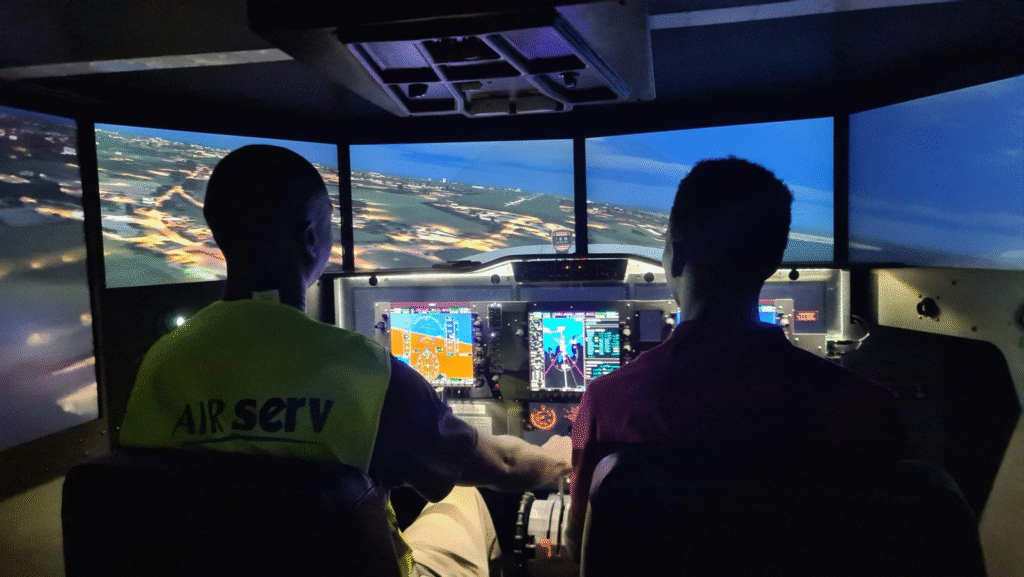
1. A Landmark Introduction: First Full Flight Simulator in Uganda
- Air Serv Uganda unveiled the country’s first full-motion flight training simulator—the Redbird CRV-S Caravan G‑1000—at Entebbe Airport. Funded by a substantial grant from the Hilton Foundation, this simulator marked a pivotal breakthrough for pilot training in Uganda. Officials, including the Uganda Civil Aviation Authority, emphasised that it constituted a “big milestone” for the national aviation industry .
- Before its arrival, pilot training relied heavily on actual flight hours, which were prohibitively expensive. Air Serv officials noted that each hour of in-aircraft instruction on planes like the Cessna Caravan cost about UGX 4,332,000 (approx. $1,140). In stark contrast, simulator sessions run only UGX 570,000 (about $150)—reduced by over 85%. This saved fuel costs, minimized aircraft wear and tear, and opened opportunities for more affordable training .
2. Strategic Benefits: Cost‑Efficient, Safe, and Accessible Training
- By shifting routine instruction into the simulator, Uganda sharply reduced training costs and financial burdens. It also provided a risk-free environment in which student pilots could hone maneuvers and emergency procedures without jeopardizing aircraft or crew safety. As one official put it, the simulator “can do all a pilot will do” in real aircraft .
- Moreover, the simulator allowed training hours logged to count toward official type-rating for the Cessna Caravan—a significant advantage for licensing and certification processes established by the Civil Aviation Authority and ICAO .
3. Broader Access: Classroom, Civil Flights, and Regional Flight Schools
- Air Serv positioned the simulator for broader use beyond its own program: offering hourly access to other flight schools, private pilots, and service providers. It also supports classroom-based and online education, enabling a blended training model combining theory, virtual simulation, and real-world flight experience .
- This makes simulator training accessible to a wider audience, including civil and regional pilots, while creating pathways for more female trainees and aviation professionals entering Uganda’s rapidly growing aviation sector .
4. Impact on Uganda Air Force Training
- While Air Serv’s simulator is civilian-operated, its commissioning coincided with Uganda Air Force efforts to modernize training. In early‑to‑mid‑2022, the UPDF Air Force unveiled its own Sukhoi Su‑30 MK2 jet simulator—a high-fidelity system designed to replicate jet flight for lead-in fighter training .
- During the commissioning, Air Force leadership emphasized reductions in fuel spend, maintenance wear, and pilot exposure to risk. The Su-30 simulator incorporation aligns with a broader pilot training enhancement strategy, helping make fighter training more sustainable .

5. Institutional Training Upgrades at Gulu Air Base
- Parallel to simulator adoption, Uganda’s Gulu Air Base—long the national cadet pilot training center—underwent infrastructure and equipment upgrades. In late 2020 Ugandan L‑39 Aerobatic trainer jets were overhauled by Ukrainian technicians to bring propulsion, avionics, and navigation systems up to modern standards—including BUR‑4‑1 data recorders, updated radios, and AI‑25TLSh engines . During a passing-out ceremony in November, 18 new pilots and 20 aviation technicians graduated under a revamped five-year training regimen .
- Additional investments included new ground school facilities, training aircraft acquisitions (Cessna 172s and L‑39s), and improved air navigation infrastructure such as VOR/DME beacons. Leadership also committed to expanding Gulu’s capacity and upgrading the airport for potential commercial use, signaling strategic synergy between military and civilian aviation interfaces .
6. Outcomes & Strategic Value of Simulator‑Based Training
- These enhancements are multiplying the Air Force’s training capacity. Simulators now handle routine hours, reducing dependence on live flights and preserving aircraft longevity. The L‑39 platform remains available for advanced flight procedures and formation training, while the Su‑30 simulator prepares fighter pilots under realistic combat and IFR scenarios.
- Combined, this layered setup supports multi-track pilot progression from cadet basics to fighter-readiness, leveraging simulation for foundational hours and reserving live flight time for refined tactical training.
7. Regional and Civil-Military Synergies
- Uganda’s investment in simulator-based training not only modernizes Air Force capacity but also benefits the broader aviation sector. Civilian schools and humanitarian operators can access simulation hours at significantly lower cost, helping to address national pilot shortages and aging workforce challenges in the industry .
- Furthermore, this shared infrastructure promotes civil–military training synergies, and could be scaled through partnerships with private institutions such as Pangea Aviation Academy, FTC Uganda, or the Soroti Flying School (East African Civil Aviation Academy) should simulation capability be adopted more broadly .


